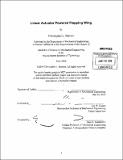Linear actuator powered flapping wing
Author(s)
Benson, Christopher Lee
DownloadFull printable version (8.088Mb)
Other Contributors
Massachusetts Institute of Technology. Dept. of Mechanical Engineering.
Advisor
Ian W. Hunter.
Terms of use
Metadata
Show full item recordAbstract
Small scale unmanned aerial vehicles (UAVs) have proven themselves to be useful, but often too noisy for certain operations due to their rotary motors. This project examined the feasibility of using an almost silent linear actuator to power a flapping wing UAV. In order to this, a wing was designed and installed into a test set-up to replicate normal flight conditions of flapping wing flight (FWF). The designs of the wing, the test set-up and the actual experiments were biomimetic, looking to approximate the flight of real birds. The main goal of this study was to characterize a novel new linear actuator being developed in the Bio-Instrumentation Lab at MIT based on important parameters for FWF including the mounting position, the frequency of oscillation and the amplitude of oscillation of the wing. Ultimately the linear actuator performed well under all of the tests and was only limited by the control software. When the frequency and amplitude of oscillation were raised, the force on the actuator increased. The mounting position ended up not having a correlation with the force on the actuator, leading one to believe that it is not a critical parameter for this actuator-wing system.
Description
Thesis (S.B.)--Massachusetts Institute of Technology, Dept. of Mechanical Engineering, 2010. Cataloged from PDF version of thesis. Includes bibliographical references (p. 58-59).
Date issued
2010Department
Massachusetts Institute of Technology. Department of Mechanical EngineeringPublisher
Massachusetts Institute of Technology
Keywords
Mechanical Engineering.